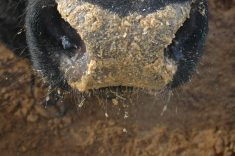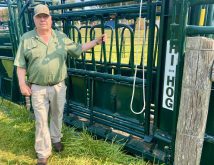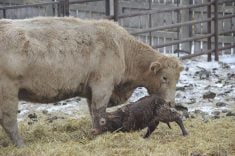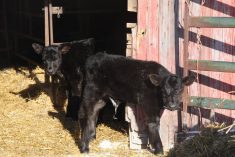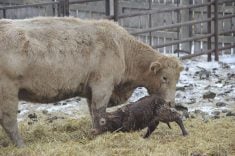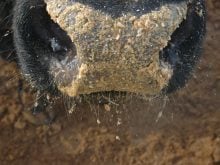Meat marbling is a significant selling point, but producers also point to the breed’s vigour, longevity, fertility and docility
Adrienne Herron has been raising Wagyu cattle in Alberta’s Red Deer County for about 15 years. She started with three unregistered purebred orphans from a local herd.
“Then I bought purebreds from Marchi Ranches in Montana, and now have registered fullbloods I sell to commercial cattle producers,” she says.
Heifers bred to Wagyu bulls don’t have calving problems and have an excellent rebreeding rate, she adds.
“We see fantastic hybrid vigour in those calves. The feedlots really like them because they rarely have to treat for sickness. In 15 years, I have never pulled a half-Wagyu calf. The calves are very vigorous at birth and get right up to suckle. I tell my commercial customers that these calves hit the ground, bounce and attach to a teat.”
Though some people think Wagyu are delicate and need barns in winter, that hasn’t been Herron’s experience.
“My fullbloods are out fending for themselves at –40 C with my Angus cows. Often the fullbloods don’t eat as much as the Angus; they are thriftier and require less maintenance, and the half-bloods are just as hardy.
“In terms of meat quality, Wagyu add value to anything they are bred to. Most of the highly successful large commercial programs use Black or Red Angus cows bred to Wagyu bulls because those cows already have some marbling capacity. This makes a good cross,” she says.
Wagyu are also long-lived and fertile. Herron’s oldest bull was 13 and covered 40 cows in its last year.
Prairie Prime Wagyu near Mann-ville, Alta., is owned by Wes Sargent and Darrel Laurenceson, two friends who grew up together. Last year Darrel’s middle son, Blake, joined the Wagyu venture as well.
Laurenceson and his wife, Sherry, also have a commercial Simmental-Angus herd and raise all their own hay, grain and straw. The Wagyu herd is mostly Japanese Black Wagyu, purchased in 2015 from a woman who started her herd in the 1990s with nine fullblood embryos from Japan.
“We bought 30 pairs from her when she needed to sell her cattle. She started with fullbloods but didn’t keep up the paperwork on registrations so we have a purebred herd with no papers,” says Sargent.
“They are very docile and easy to handle and become pets. Most people think Wagyu are small cattle, but even though they are small at birth, they grow nicely. The herd bull we raised, that we call Alvin, weighs about 2,400 pounds, but throws a 70 to 80 lb. calf.”

Calving ease and good growth potential are a great combination, he adds.
“We have never pulled a calf. I recommend a Wagyu bull for use on heifers of any breed.
“One thing we don’t do with our Wagyu is breed yearling heifers or bulls. We wait until they are two. We don’t sell yearling bulls; we sell two-year-olds. We’ve found that breeding heifers as yearlings tends to stunt them. They do better if you wait until they are more mature. Then they become good cows and have a long productive life and are better milking,” says Sargent.
Wagyu are not great at milk production, so selective breeding helps.
“We took a hit on marbling to get bigger cattle and better milk production, and we’re happy about the way our herd is milking now,” he says.
Prairie Prime has red and black Wagyu but plans to phase out the reds.
“We’ve found that the black Wagyu marbles a little better. We used the red for a while, to get a little more size and milk, but now want to concentrate more on the black.”
Every Prairie Prime animal is DNA tested for marbling using the Australian marbling score.
“We’ve done this from the time we bought the herd. Marbling is rated from zero to 10 and the higher the number, the more marbling the animal will have. Since Wagyu are fine-boned, we get more meat in the meat-to-bone ratio than with other breeds, and this is key in the meat business,” Sargent says.
The Wagyu cattle are wintered with the commercial Simmental-Angus cows and are less expensive to feed because they eat about 20 percent less than a typical beef cow.
However, it takes longer to grow them out for market.
“Feeding them for 30 to 40 months has been working for us. We sell half or whole carcasses to customers locally and through our website. We also sell to two high-end meat-market shops. The demand for this meat is greater than what we can currently supply. Our meat is all spoken for through 2022 and 2023.”
In 2022, the partners calved out 50 cows and will calve 70 in 2023.
“We are keeping all our heifers, trying to grow our herd. I think the only way breeders can supply the restaurants in North America is with F1 animals. A major steakhouse will serve 200 to 250 steaks in a night and the only way to supply that many is with higher numbers of animals, by using Wagyu bulls on herds of other breeds,” says Sargent.
Jeannot Luckenuik has a small farm at Drummondville, east of Montreal. He has been raising cattle for more than 30 years, starting with Angus and selling meat to a local restaurant.
“Then the cook contacted me and said he found something even better than my Angus, so I wanted to know what it was. I went on the internet and found out about Wagyu,” says Luckenuik.
“So, I visited a breeder in Formosa, Ont., bought some meat and a bull from him, and that’s how my new adventure started.”
He used that bull on his Angus cows and gradually built his Wagyu herd.
“Our business is more about the marbling than the breeding. Every time we slaughter one, we take a piece of rib steak to see the marbling, and I send that to my customers so they know what they will have,” says Luckenuik.

“There are two of us in this program (Wagyu Quebec), Guy Noiseux and myself. We each have a farm, within half an hour’s drive from one another, and went in together to have enough cows for our meat program. We also buy a few calves from a friend who has about 50 Angus cows he breeds to Wagyu bulls.
“The first time Guy got some Wagyu, his father looked at him like he’d lost his mind. Those cattle didn’t look like beef animals. Everyone thought we were crazy at first. When they saw the bull, they said he had no backside and small testicles. People have to learn about this breed,” he says.
At first, they gave away meat, saying it was Kobe style because few people had heard of Wagyu. Now people ask for it, says Luckenuik.
The two breeders do all the marketing themselves, direct to customers. Wagyu Quebec also sells meat to a large hotel in Montreal. In 2016, they participated in an event where more than 300 people tasted various products made with Wagyu.
“People like the idea that we use every part of the carcass. There were hot dogs and sausage, pastrami made from the heart, jerky, smoked liver, ham made with Wagyu, as well as cookies, brownies and other pastries made with the fat. This tasting event was a great success, to show people that Wagyu is a lot more than just an excellent rib steak and filet mignon.
“A few breeders in Quebec are raising only fullbloods and saying the fullblood is better. Yes, fullblood is better but you might only sell five animals per year because it’s very expensive. My Angus cows can make lots of F1 crossbreds so more people can afford to taste it,” says Sargent.



